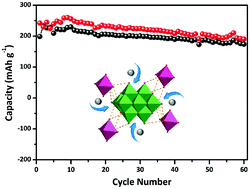当前位置:
X-MOL 学术
›
Inorg. Chem. Front.
›
论文详情
Our official English website, www.x-mol.net, welcomes your feedback! (Note: you will need to create a separate account there.)
Boosting the ultrastable Li storage performance in electron-sponge-like polyoxovanadates by constructing inorganic 3D structures
Inorganic Chemistry Frontiers ( IF 7 ) Pub Date : 2017-10-13 00:00:00 , DOI: 10.1039/c7qi00581d Shanshan Lu 1, 2, 3, 4, 5 , Yang Lv 5, 6, 7, 8 , Wenqing Ma 1, 2, 3, 4, 5 , Xiaofeng Lei 1, 2, 3, 4, 5 , Ruie Zhang 1, 2, 3, 4, 5 , Hong Liu 5, 6, 7, 8 , Xizheng Liu 1, 2, 3, 4, 5
Inorganic Chemistry Frontiers ( IF 7 ) Pub Date : 2017-10-13 00:00:00 , DOI: 10.1039/c7qi00581d Shanshan Lu 1, 2, 3, 4, 5 , Yang Lv 5, 6, 7, 8 , Wenqing Ma 1, 2, 3, 4, 5 , Xiaofeng Lei 1, 2, 3, 4, 5 , Ruie Zhang 1, 2, 3, 4, 5 , Hong Liu 5, 6, 7, 8 , Xizheng Liu 1, 2, 3, 4, 5
Affiliation

|
Polyoxometalates act as an electron sponge, processing multielectron redox reactions and acting as a fast ionic conductor. They show great potential as promising electrode materials for next-generation lithium ion batteries (LIBs). However, there are still some fundamental issues which should be solved before their application can be realized, such as determining the stable structural feature with reversible Li+ ion insertion/desertion. In this work, polyoxovanadates (POVs) based materials of K4Na2V10O28·nH2O (KNaV10) and Mg2(NH4)2V10O28·nH2O (MgV10) have been prepared and used as the electrode material for a Li+ ion reservoir. The 10-core polyoxovanadate is demonstrated as a anionic building block and the 3D extended structure has been smartly tuned by counter cations. For MgV10, a 1D tunnel with an approximate size of 3 Å × 10 Å was formed along the a axis by Mg2+ ions and [V10O28]6− polyanions. The MgV10 shows a higher capacity, cycling stability, and rate performance than that of KNaV10 without tunnels. The capacity of MgV10 is about 160 mA h g−1 at a high discharge rate of 250 mA g−1, while it is only 118 mA h g−1 for KNaV10. Even after 60 discharge/charge cycles at 50 mA g−1, it displayed a capacity of 180 mA h g−1. The 1D tunnel in MgV10 facilitates the Li+ ion transport and provides spatial Li storage sites, which promotes the electrochemical performance in LIBs. Moreover, the Mg2+ ions remained stable during battery cycling and promoted the 3D structure stability. This work demonstrates promising guidelines for the structural design of POVs based materials for Li storage.
中文翻译:

通过构建无机3D结构来提高电子海绵状聚氧钒酸盐中超稳定的Li储存性能
多金属氧酸盐起电子海绵的作用,处理多电子氧化还原反应并起快速离子导体的作用。它们显示出巨大的潜力,可作为下一代锂离子电池(LIB)的有前途的电极材料。但是,在实现其应用之前,仍然存在一些基本问题需要解决,例如通过可逆的Li +离子插入/脱键确定稳定的结构特征。在这项工作中,基于聚氧钒酸盐(POV)的材料为K 4 Na 2 V 10 O 28 · n H 2 O(KNaV 10)和Mg 2(NH 4)2 V 10已经制备了O 28 · n H 2 O(MgV 10),并用作Li +离子储存器的电极材料。10核聚氧钒酸盐被证明是一种阴离子结构单元,并且3D扩展结构已通过抗衡阳离子进行了巧妙的调节。对于MgV 10,由Mg 2+离子和[V 10 O 28 ] 6-聚阴离子沿a轴形成尺寸约为3Å×10Å的一维隧道。与没有隧道的KNaV 10相比,MgV 10具有更高的容量,循环稳定性和速率性能。MgV的容量10在250 mA g -1的高放电速率下约为160 mA hg -1,而对于KNaV 10仅为118 mA hg -1。即使在以50 mA g -1进行60次放电/充电循环后,它的容量仍为180 mA hg -1。MgV 10中的1D隧道促进了Li +离子的运输,并提供了空间Li储存位点,从而促进了LIBs的电化学性能。此外,Mg 2+离子在电池循环期间保持稳定,并促进了3D结构的稳定性。这项工作证明了基于POV的锂存储材料的结构设计的有希望的指导方针。
更新日期:2017-10-25
中文翻译:

通过构建无机3D结构来提高电子海绵状聚氧钒酸盐中超稳定的Li储存性能
多金属氧酸盐起电子海绵的作用,处理多电子氧化还原反应并起快速离子导体的作用。它们显示出巨大的潜力,可作为下一代锂离子电池(LIB)的有前途的电极材料。但是,在实现其应用之前,仍然存在一些基本问题需要解决,例如通过可逆的Li +离子插入/脱键确定稳定的结构特征。在这项工作中,基于聚氧钒酸盐(POV)的材料为K 4 Na 2 V 10 O 28 · n H 2 O(KNaV 10)和Mg 2(NH 4)2 V 10已经制备了O 28 · n H 2 O(MgV 10),并用作Li +离子储存器的电极材料。10核聚氧钒酸盐被证明是一种阴离子结构单元,并且3D扩展结构已通过抗衡阳离子进行了巧妙的调节。对于MgV 10,由Mg 2+离子和[V 10 O 28 ] 6-聚阴离子沿a轴形成尺寸约为3Å×10Å的一维隧道。与没有隧道的KNaV 10相比,MgV 10具有更高的容量,循环稳定性和速率性能。MgV的容量10在250 mA g -1的高放电速率下约为160 mA hg -1,而对于KNaV 10仅为118 mA hg -1。即使在以50 mA g -1进行60次放电/充电循环后,它的容量仍为180 mA hg -1。MgV 10中的1D隧道促进了Li +离子的运输,并提供了空间Li储存位点,从而促进了LIBs的电化学性能。此外,Mg 2+离子在电池循环期间保持稳定,并促进了3D结构的稳定性。这项工作证明了基于POV的锂存储材料的结构设计的有希望的指导方针。



























 京公网安备 11010802027423号
京公网安备 11010802027423号